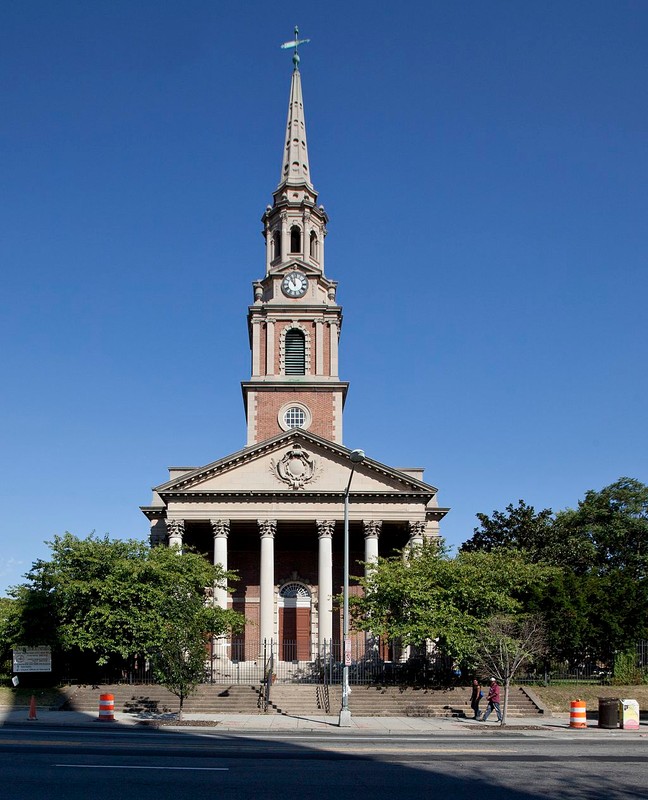All Souls Church, Unitarian
Introduction
Text-to-speech Audio
Home to a leading progressive Unitarian Universalist congregation founded in 1821, All Souls Church, Unitarian was built in 1924 as the third church for the congregation. Modeled after the St. Martin-in-the-Fields church Trafalgar Square, London, it was designed by Boston architecture firm Coolidge and Shattuck in the Colonial Revival style, which was popular in the country at the time. Built of red brick with limestone trim, notable features include a grand portico with six limestone Corinthian columns supporting an entablature, Corinthian pilasters along the sides of the church, and a clock tower topped with a spire that is 160-feet tall. It was added to the National Register of Historic Places in 2020.
Images
All Souls Church, Unitarian was built in 1924 and is home to congregation established in 1821. The congregation has been at the forefront of progressive causes since its founding.

Backstory and Context
Text-to-speech Audio
All Souls, Unitarian
A group of 27 founders, which included several leading figures of the day including future U.S. President John Quincy Adams (in office 1825-1829), his future Vice President John C. Calhoun, and the architect of the U.S. Capitol, Charles Bulfinch, established the church in November 1821. They founded the church as an independent entity, "unfettered by human creeds and unawed by the mandates of popes, bishops, presbyters and councils, synods and sessions and all the contrivances by which spiritual pride seeks to control the conscience of men." It is believed that Bulfinch donated part of his property for the construction of the congregation's first church, which he designed in the Greek Revival-style. Completed in 1822 and named First Unitarian Church, it was located at 6th and D Streets NW. The 1,000-pound bell was cast by the son of Paul Revere, John Revere, who operated a foundry in Canton, Massachusetts.
The second church was built in 1878 and was at 14th and L Streets NW. Named All Souls, Unitarian, it fulfilled the congregation's need for a larger worship space. The congregation and Unitarians around the country also wanted a national church, which would increase the religious and political stature of the Unitarian church in the nation's capital. Other denominations built national churches of their own as well. Architect Rufus T. Russell designed All Souls, Unitarian church in the Victorian Greek Revival style. The word "unitarian" was likely placed at the end of the church's name to promote religious inclusiveness.
The congregation grew during the following decades and many prominent figures, including President William Howard Taft, cabinet members, senators, and congressmen became members. The congregation became more active in the community as well. As a result of this growth, it became clear that the church was too small and the effort to erect a new building began in 1911. Construction began in 1914 but work stopped during World War I. Work restarted in 1922 and it was finally completed in 1924.
Social Activism and Community Life
All Souls, Unitarian has long been a bastion of progressive activism. In the pre-Civil War years, however, the issue of slavery divided the congregation, which was composed of northerners and southerners. Most of the ministers were abolitionists, however. One of them was Bulfinch's son, Stephen, who served as minister from 1838-1844. He invited Quaker activist Lucretia Mott to speak at the church about women's rights, temperance, abolitionism, and peace. As a well-known figure nationally, her talk attracted a large crowd and a lot of attention. Many disagreed with her views. During the Civil War, the church was used as a hospital for wounded soldiers but it also hosted national speakers such as Frederick Douglas and, at least once, President Abraham Lincoln. Over the following decades, the congregation expanded its social and community activities, including establishing a day care and kindergarten. In 1896, a group called the Women's Alliance was founded and provided food to outside organizations.
After the present church was built, congregants could participate in a number of activities and events. These included movies, dances, lectures, and basketball. Community organizations met at the church as well such as boy's scouts, a girl's club, various sports clubs, the Business and Professional Women's Club, and the Pierce Hall Players. In keeping with the church's progressive ideals, the dining room was racially integrated.
During the 1940s and 1950s, the congregation fully supported social justice causes and became more integrated. In 1946, the church established an organization called the Washington Chapter, Unitarian Fellowship for Social Justice. It held monthly meetings dedicated to discussing local, national and international issues of the day. In 1947, the church voted in support of a presidential report on civil rights. In 1953, the congregation compiled a list of local, whites-only establishments and distributed it to the public to encourage residents to avoid those places. These and other activities attracted African Americans to the church.
All Souls continued to be active in the Civil Rights years of the 1960s. After four African American girls were killed in a church bombing in Birmingham, Alabama in September 1963, an organization called the Congress for Racial Equality organized a large protest march that started at All Souls and ended at the White House. In 1969, the first African American minister was appointed to lead the church (he served until 1992). Other activities in the 1960s included creating a birth control clinic, starting an anti-poverty effort called the Girard Street Project, and establishing a surplus food distribution program. In the 1970s through today, the congregation has actively supported LGBTQ rights and causes. In 2009, the mayor signed the city's Marriage Equality Act into law at All Souls. Today, the congregation is active in supporting a variety of causes such as gun control and the rights of immigrants and refugees.
Sources
"History of All Souls." All Souls Church, Unitarian. Accessed October 17, 2022. https://all-souls.org/about-us/history.
Williams, Kim. "All Souls, Unitarian." National Park Service - National Register of Historic Places Nomination Form. https://planning.dc.gov/sites/default/files/dc/sites/op/publication/attachments/All%20Souls%20Church%20Landmark%20application.pdf
Wikimedia Commons: https://commons.wikimedia.org/wiki/File:All_Souls_Church_DC_Highsmith.jpg
